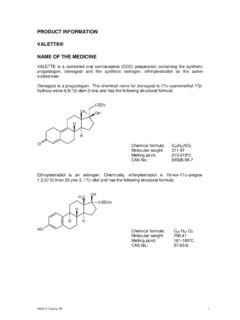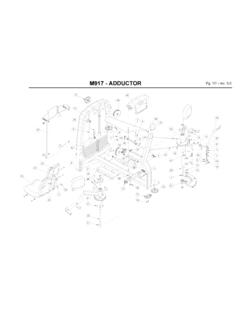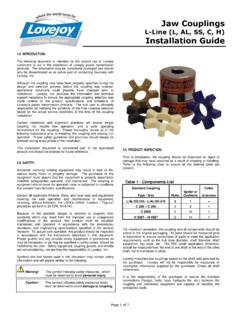Transcription of New Confidor Guard keeps grubs out of cane.
1 New Confidor Guardkeeps grubs out of PERMIT USE PRODUCT IS NOT canegrub management23 Cost effectiveness In trials conducted in the last two yearsConfidor Guard treated cane generallyprovided at least a 20% increase inyield compared to untreated cane thatwas damaged by greyback canegrubs. For crops yielding around 85 tons/ha(at 7 US c/lb for sugar) this would givean increased income after harvestingcosts of about $279/ha. For crops yielding around 116 tons/haa 20% yield increase would giveadditional income of around $485/ha. If the crop is damaged badly enough itwill have to be replanted and this cancost $1000 $1500/ha. Protection with Confidor Guard at L/ha to L/ha costs considerablyless than the potential increased returnand may save having to mode of action Confidor Guard works very differentlyfrom older insecticides such as theorganophosphates (OPs).
2 Confidor Guard : works more slowly on the nervoussystems of insects lasts somewhat longer directly influences insect behaviour. Anti-feeding effectCane grub larvae that receive a dose of Confidor Guard immediatelyreduce their feed intake and will often stop feeding short-term effect is to reduce cropdamage. When the feeding is stronglydisrupted, larvae weight gain can beeither reduced or totally stopped. Thiscan also lead to a valuable longer-termeffect: canegrub larvae need toaccumulate fat reserves and reach acertain size before they can successfullypass through the pupal stage to becomeadult beetles. Underweight larvae do notturn into adult placementA plant systemic insecticide can betaken up by the roots of plants, andtravel within the plant with the sap canegrub insecticides are not plantsystemic: they are only effective ifcanegrubs came into direct contact withthe chemical in the soil.
3 Accurateplacement of OPs in relation to the rootsystem is therefore essential for good contrast, Confidor Guard is a systemicinsecticide. This allows excellentflexibility in its placement: Confidor Guard can act againstcanegrubs by direct contact in the soil just like OPs. Confidor Guard can be ingested(eaten) by the pest eg whencanegrubs attack roots of cane thathave been treated with ConfidorGuard; or when grubs consume some soil as they feed in the rootmass. Ingestion provides greateractivity against insects than directcontact. To a limited extent, Confidor Guardcan also move within the soil mainlywith the wetting front, as soil moisturechanges in the soil.
4 This watermovement can be used to ensure thatthe active ingredient moves into thecane stool GuardConfidor Guard is a liquid flowable (suspension concentrate) insecticide that contains 350 g/L of imidacloprid the unique active ingredient. Imidaclopridbelongs to a new class of insecticides called the chloronicotinyls. This photograph shows a trap crop in the Burdekin, marked with the arrow, that hasattracted sufficient grubs to kill the cane. The two green strips were protected by ConfidorFlexible timing Confidor Guard acts at very low rates ofactive ingredient, and does not appearto break down at rapid or enhancedrates. As a result, application can betimed to deliver an extended period ofcontrol.
5 For example, research hasmeasured very good efficacy againstseveral species of grubs in March/April,from applications madeduring September/Octoberin theprevious Guard tends to work betterwith earlier rather than later applications because the action against smallerstages of canegrubs (eg 2ndinstarlarvae, or small 3rdinstars) is strongerthan against large mature grubs . 0 Larvae/stooluntreatedcontrol612345 Rate (L/ha)Effect on Numbers of (L/ha)Tonnes cane/hauntreatedcontrolEffect on Yield0 Mean larvae/stoolMean larvae weight (mg)8920001800185019001950 UntreatedcontrolConfidor LConfidor LRugby 100 kg 12346 Rate (L/ha)75 Effect on Numbers of LarvaeMean larvae/stoolMean larvae weight (mg)Tonnes cane/ha806040200 Rate (L/ha)UntreatedcontrolConfidor LConfidor Guard LEffect on YieldRugby 100 kgFigure 3.
6 Childers canegrub control with Confidor at 54-55 , Qld. 2000/2001 Figure 3 shows significantly reduced numbers of third-instar Childerscanegrub larvae in Confidor treated plots compared to the untreatedcontrol. Larvae remaining in plots treated with Confidor weresignificantly lighter than those treated with Rugby or the 4. Yield responses with Confidor against Childers canegrubat 260 DAT. Childers, Qld. 2000/2001 Figure 4 the same trial, shows that cane yields were significantlyhigher (25-30 tonnes cane per hectare) where Confidor was appliedcompared to the untreated control. There was no significant differencebetween Confidor and Rugby, although the yields trended higher with thehigher label application rate of results using Confidor Guard on greyback canegrub (Dermolepida albohirtum)Figure 1: Efficacy of Confidor Guard against greyback grubs at aheavily infested site at Little Mulgrave in Far North trial clearly showed that in situations where numbers of grubs arehigh, higher rates were needed to obtain good levels of 2.
7 Yield responses with Confidor Guard against greybackgrubs at the same site at Little Mulgrave in Far North rates gave significantly higher yield responses at this heavilyinfested site. Confidor Guard at L/ha gave a yield benefit of about30 tonnes cane per results using Confidor Guard on Childers canegrub (Antitrogus parvulus)4 AssessmentGreyback canegrubs mostly lay eggsfrom November until January. By thetime the first grubs can be found inJanuary, most cane will be too large totreat. Waiting until grubs are presentbefore applying the insecticide is thusnot feasible. In ratoon cane, in mostcases it is necessary to apply theinsecticide either before or soon afterthe adults fly.
8 The recommended approach is toassess the risk of infestation across thefarm prior to treatment. This helpsidentify which areas are highly likely tobe attacked and need selectivetreatment. Typical high-risk areas forgreyback canegrubs are: blocks that have had a history ofdamage and/or blocks that appear tallest and mostattractive to flying adults eg earlycut sections. In some regions, harvest sequenceand selective application of Confidormay become valuable techniqueswithin an integrated system ofgreyback canegrub management. We recommend evaluating the relative risks to each field across thewhole instructionsRate:16 22 mL per 100 metres ofcane row (equivalent to L/hafor single row cane with mspacing between rows).
9 The high rateis used when high grub populationsare expected (eg an average greaterthan 4 grubs per stool).It is important that growers monitor thenumber and species of grubs that aredamaging their crop, because: Recommendations given for treatmentwith Confidor Guard relate to certainspecies only. The treatment rate is based on thenumber of canegrubs estimated to bepresent (or expected to be present) ineach section of cane. Canegrub numbers are usually measuredas grubs per stool of cane. The growercan calculate the approximate averagegrub numbers in an area of cane by: selecting 10 stools spaced throughout the area digging them out to a depth of 40 cm, leaving a hole 40 cm square inspecting the excavated soil and rootsand identifying and counting thecanegrubs found in this process averaging the number over the 10 stools checking the size (growth stage) ofeach grub grub damage and number to determine treatment required 5 Using Confidor Guard to control greybackcanegrub (Dermolepida albohirtum)
10 4 Lifecycle characteristics Some canegrub species have a two-year lifecycle, which includes an over-wintering phase when grubsmove deep in the soil profile duringcolder months and come up again to feed on cane roots in early canegrub species have a one-year lifecycle and no overwinteringphase. Larvae from all species go into a pupalstage before emerging as adultbeetles, which fly in spring andsummer each season. After feeding and mating, adult beetleslay eggs in cane fields. A few weeks later these eggs hatchinto small grubs (1st instar larvae) thatfeed on organic matter in the soil. Aftermoulting into the medium-sized (2ndinstar) and larger (3rd instar) larvae, thegrubs start causing damage to caneroot systems.




